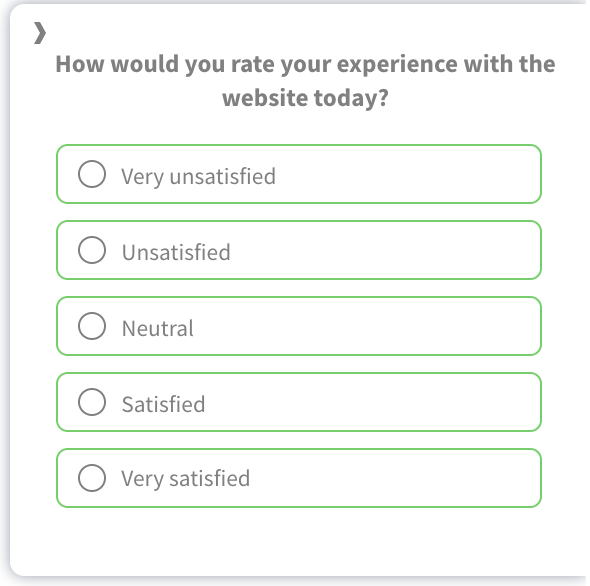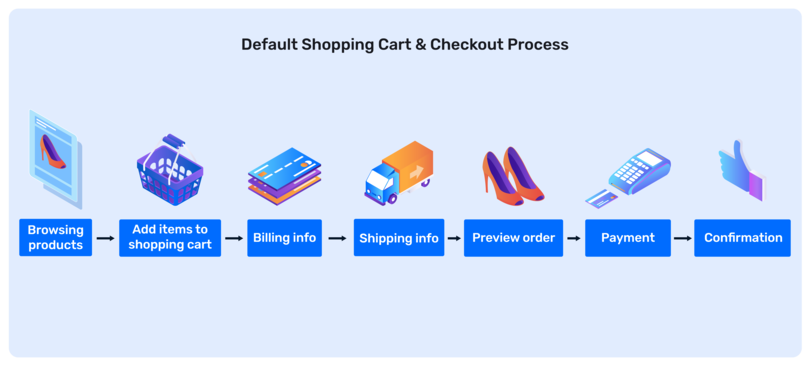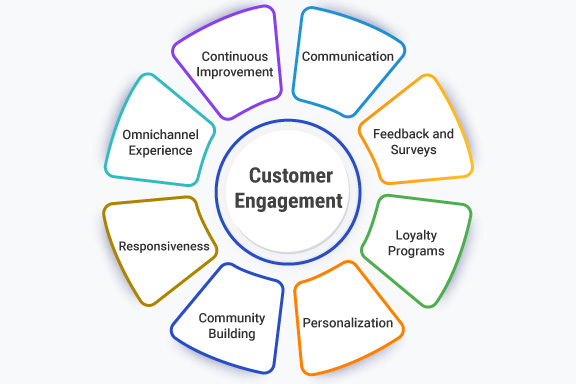The first step towards improving the eCommerce customer experience is recognizing your customers as individuals with diverse experiences, needs, challenges, desires, and objectives.
While you may not engage with them on a personal level, you can treat customer segmentation as more than just analysis. The options for tapping into what your customers want can vary from direct interaction to developing empathy maps.
In this article, we’ll explore strategies for creating an eCommerce customer experience that delivers exceptional effectiveness and embodies authenticity.
What Does the eCommerce Customer Experience Include?
The broad definition of eCommerce customer experience is likely not a mystery to you. However, when discussing how to improve customer experience in eCommerce, it’s essential to identify its components.
The following elements contribute to the overall customer experience in eCommerce.
Website Experience

Website Design
Your website’s visual appeal, layout, and usability are the first things that 94 percent of users notice. It takes them 50 milliseconds to decide whether to keep scrolling or leave.
Navigation
People spend an average of 6.44 seconds focusing on your website’s navigation and whether they can find products quickly and efficiently. They prefer concise menus, intuitive product page navigation, good search functionality, and relevant filters.
Page Load Speed
According to Think with Google, the bounce probability increases by 32 percent as page load time goes from one to three seconds. Slow loading times can frustrate customers, leading to abandonment.
Mobile Optimization
Over 55 percent of users use mobile phones to purchase online. Moreover, 50 percent of smartphone users prefer using a mobile-optimized website when shopping or browsing because they don’t want to download a mobile app.
Shopping Process

Product Pages
These elements are crucial for selling your items, as they are where the purchasing magic happens. Plus, according to a recent survey, 85 percent of shoppers said product information and pictures were important when deciding which brand or retailer to buy from.
Checkout Process
Baymard Institute discovered that the average documented online shopping cart abandonment rate exceeds 70 percent. To mitigate this, you must ensure a streamlined and user-friendly checkout process with simplified forms, multiple payment options, guest checkout, and saved billing and shipping information.
Shipping and Delivery
Transparent shipping costs, delivery options, order tracking, and timely delivery are all a part of the customer experience in eCommerce.
Returns and Refunds
Website users anticipate a hassle-free returns policy with clear instructions and prompt refunds; otherwise, they may opt for another eCommerce business.
Customer Engagement

Customer Support
Should any issues or questions arise, your customers expect responsive and knowledgeable customer support across various channels, including live chat, email, and phone.
Personalization
This non-negotiable element requires tailored product recommendations, promotions, and content based on customer preferences, browsing history, and purchase behavior.
Security and Trust
Displaying Trust badges, secure payment options, and transparent privacy policies make your eCommerce more credible and build trust and confidence among your customers.
Social Proof
Remember that customer reviews, ratings, testimonials, and social media integration provide social proof and influence purchasing decisions, making them a vital element of a customer experience.
Cross-selling and Upselling
You can streamline your customers’ decision-making by recommending related or complementary products during their shopping journey. This also helps increase the average order value.
Community and Engagement
The eCommerce customer experience surpasses the technical website aspects. It includes ensuring customers feel a sense of community through user-generated content, forums, loyalty programs, and social media interactions to drive their engagement and loyalty.
Post-Purchase Communication
Customer experience also includes sending order confirmation emails, shipping notifications, and follow-up emails for feedback or additional offers, keeping customers informed and engaged post-purchase.
Accessibility
Users with disabilities should enjoy an equally seamless experience as other users. Expand user experience inclusivity by including screen readers and keyboard navigation.
Localization
Despite often being underappreciated, this eCommerce customer experience element is just as crucial as others. It’s imperative to tailor content, language, currency, and payment options to the preferences of various regions or countries to enhance the relevance and usability of the website for international customers.
9 Best eCommerce Customer Experience Tips
The following are the most effective strategies to improve customer experience in eCommerce.
1. Understand Your Customers
Base each strategy on a detailed customer profile, moving beyond demographic data.
Understand their identities, preferences, concerns, and expectations from eCommerce businesses. This insight is necessary for personalized approaches that resonate with customers.
How do you collect that data?
- Customer Interviews and Surveys: Engage in meaningful conversations with customers to understand their experiences, challenges, and aspirations. Ask open-ended questions and actively listen to their responses for insights that quantitative data might miss.
- Co-creation Workshops: Collaborate with customers to develop and refine products or services, creating a sense of ownership and aligning solutions with their needs and preferences.
- Empathy Mapping: Create empathy maps to visualize customers’ thoughts, feelings, and behaviors. Putting yourself in your customers’ shoes gives a more complex understanding of their motivations and pain points.
- Continuous Feedback Loops: Establish mechanisms for ongoing feedback and communication with customers. For instance, you can include feedback forms, suggestion boxes, or online communities where customers can share their thoughts and ideas.
- Customer Journey Mapping: Map out the entire customer journey to identify key touchpoints and moments of truth. That gives you a holistic view of the customer journey, helping you pinpoint pain points and opportunities for improvement.
2. Gauge Your eCommerce Website
Audit your eCommerce website visuals to determine customer appeal, but instead of solely assessing aesthetics, focus on navigation and speed. Identify potential obstacles impacting customers’ ability to find products or services and ensure all the pages load swiftly.
Moreover, you can analyze content clarity and informativeness. If the content is satisfactory, evaluate the ease of navigation and shopping cart modification. Finally, assess the promptness, effectiveness, and politeness of customer service.
This data can guide your next steps and provide insight into the current customer experience.
3. Ensure Your Website is User-Friendly
Easy-to-navigate pages are paramount for visitors browsing your eCommerce website. Arrange your pages, categories, and content in a way that makes it easy for them to find what they need.
Make the search button accessible and visible and ensure users can understand their current location within the website. They should swiftly backtrack to previous categories or search results if needed. Thirty-six percent of retailers often disregard that and fail to accommodate the entire product catalog hierarchy into their breadcrumbs.
When improving your site’s navigation, remember that some customers know exactly what they want, and others are solely browsing. However, many need help finding their way through your products.
4. Target Content Using Relevant Customer Data
Personalization depends on everything you know about your customers. In the first step, we already suggested how to meet your target audience, but you can combine that data with your AI analytics.
Gauge your customers’ browsing behavior, demographic info, purchasing history, and how they interact with your website. Another helpful tool you can use is heat maps, as they show how users respond to your layout, products, categories, and displays.
That data can help you customize content and suggest targeted recommendations. For example, if a customer frequently purchases running shoes and accessories, the website can suggest complementary items such as running apparel, water bottles, or fitness trackers.
You can also enable your customers to create customizable profiles where they can add their preferred clothing styles, brands, interests, sizes, and favorite product categories.
5. Create Striking Visuals
Captivating and high-quality visuals appeal to customers, regardless of your industry. Over 77 percent prefer to see other customers’ photos rather than professional shots before making a purchase decision.
Moreover, a product demo video increases conversions by 64 percent.
The following ideas can help you improve the eCommerce customer experience through visuals that showcase items effectively:
- High-quality product images: Offer customers a comprehensive visual experience by providing stellar images from various angles, investing in professional product photography for accurate representation, and enabling viewing in diverse contexts like lifestyle images, videos, or 360-degree views.
- User-Generated Content (UGC): Share UGC on social media and community forums, curating and displaying this content on product pages for authentic social proof. You can also implement user-friendly tools like hashtags and tagging to facilitate content submission.
- Interactive Visuals: Consider integrating interactive features like image sliders, augmented reality (AR) try-on experiences, and customization tools, enabling customers to interact with products dynamically and personalize their shopping experiences in real time.
6. Use Chatbots
Provide your customers with an AI-powered live chat experience, enabling instant responses to frequent questions. Chatbots can provide instant assistance to customers, address inquiries, and provide support even outside of regular business hours.
They can also use customer data and previous interactions to offer personalized recommendations, product suggestions, and tailored assistance based on individual preferences and purchase history.
Retailers often disregard the helpfulness of chatbots in automated order processing. These AI fellas can assist customers with order placement, tracking, and status updates, streamlining the purchasing process and reducing friction.
7. Boost Your Customer Support
Customers should have no doubts about how to reach you or find relevant info. Otherwise, they might question your brand transparency and commitment to a top-notch shopping experience.
The following practices will help you ensure you provide a great CS:
- Your return policy is easily accessible across multiple areas of your website, including the footer, product pages, and shopping cart.
- You display shipping rates and delivery times early in the checkout process to avoid doubts and surprises.
- You ensure customers can swiftly find your privacy policies in the website footer.
- Customers can track their package’s status in real time.
- Your company values are present across the website in every visual, text, and product.
- Customers can easily find your physical stores thanks to a live map locator.
- Customers can locate nearby stores that carry your products for convenient local shopping.
8. Leverage Generative AI
Generative AI in eCommerce can streamline your content strategy, helping you create visuals and text. For instance, ChatGPT can assist you with website copy, email marketing, and product descriptions, while Midjourney can create striking imagery.
Another recent tool that can improve your customer experience is Sora AI. This tool generates video from texts, and you can try prompting it to create everyday people wearing or using your products.
Moreover, gen-AI can participate in analyzing product quality, optimizing in-person checkout, or predicting supply chain disruptions.
9. Ensure Your UX is On Point
User experience (UX) and customer experience (CX) need each other to work well. The former includes user interaction with a product or service, ease of use, accessibility, and overall satisfaction.
However, it helps shape CX by ensuring seamless navigation, intuitive design, and efficient functionality. As a result, you should assess whether your eCommerce website is optimized for both. You can achieve that by monitoring various metrics, including user engagement, conversion rates, customer feedback, and satisfaction scores across all touchpoints.
How Security Measures Impact the Customer Experience in eCommerce
Safe and robust security protocols are among the best eCommerce customer experience practices. They reassure customers their sensitive information, such as payment details and personal data, is safe from unauthorized access and cyber threats.
But stringent security measures also improve your brand credibility and reputation. Here are a few steps you can take to ensure your customers are safe when browsing and purchasing on your website:
- Implement SSL encryption to secure data transmission between your customers’ devices and your website server.
- Use HTTPS protocol to ensure a secure connection throughout the browsing and purchasing process.
- Add robust authentication measures, such as multi-factor authentication, to verify customers’ identities and prevent unauthorized access.
- Update and patch security vulnerabilities in the eCommerce platform to mitigate the risk of cyber-attacks.
Customer experience encompasses all touchpoints between a customer and your business, including their perceptions, feelings, and interactions across channels. However, potential obstacles and friction can affect satisfaction and loyalty, requiring effective strategies for mitigation.
If you need assistance to improve your customer experience, consider working with professionals providing ecommerce website development services.





